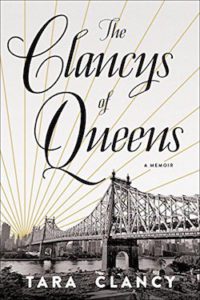
As the daughter of a divorced Italian-American social worker from Brooklyn and an Irish-American cop from Queens, Tara Clancy had an unusual childhood in 1980s New York City. She hopscotched among her father’s converted boatshed apartment, her feisty Italian grandparents’ home, and her mom’s millionaire boyfriend’s Hamptons estate. A born storyteller, Clancy has turned her ability “ to jump social strata in a single bound” into wonderful tales as a Moth GrandSlam winner and an essayist in the New York Times, the Paris Review Daily and The Rumpus. Her new memoir, The Clancys of Queens, contains these pieces and expands on them.
Clancy’s keen observational humor and authentic working-class New Yawkese survive the transition from stage to page as she crafts a love letter to the family that raised her.
When I twist the mental radio-tuner dial of my memory as far back as it’ll go, I get staticky snippets of my parents and me from my earliest days, but that sweet crystal-clear reception actually first comes in on the time I spent with my grandparents. In other words, as best I can remember, life begins for me in a tiny ad hoc geriatric Italian village on 251st Street in Bellerose, Queens.
With both my mom and dad working double-time after their divorce, starting at age three I spend the weekdays in the care of my grandma, Rosalie Riccobono, who lived, of course, with my grandpa, Bruno “Ricky” Riccobono, who in turn shared a two-family house with my great-aunt, Mary Zacchio, that just happened to be next door to the homed of two other Italian-American septuagenarian couples, Tina and Lenny Cirranci, and Anna and Joe Paradise. And though I was with my parents on weeknights and weekends, bouncing between their vastly different worlds, my most vivid early memories are born in this four-hundred-meter stretch of street, in these three abutting houses, with these seven elderly Italians.
Clancy sketches these people with telling details and great affection. Her grandpa calls her “Shrimpy” and is “as close to Buddha as an Italian-born, Brooklyn-bred, truck-driver-turned-life-insurance-salesman has ever been.” The Carrancis’ house “was its own universe of periwinkle and crystal, with the smell of Aquanet and Chesterfields imbedded in the wall-to-wall carpeting.” The Paradises’ sunlit kitchen was “full of glowing, seventies-era, harvest-gold appliances” and a watered-down glass of orange juice always waiting for young Tara. Grandma peppers her speech with her favorite expression: fahngool. (Clancy helpfully translates: “Fahngool is the Italian American pronunciation of the slang word vaffanculo, which translates to “go do it in the ass” though it is used more like ‘fuck off.’ Either way, it’s not a nice thing to yell at a five-year-old. But Grandma means nothing by it. ‘Fuck’ is just her go-to, catchall punctuation.”) Clancy’s world expands to include her mother’s boyfriend’s Bridgehampton world of limousine rides, lazy country afternoons, and existential after-dinner conversations.
People die, people marry, relatives move away. As Tara gets older, the foundation of her life shifts a bit. She focuses on classmates rather than family. She’s always been hyperactive, rule-breaking, “untethered,” but by the age of ten she is “a tried-and-true child chameleon, a real-life little Zelig who knew how to go from being a barfly at a Queens local hangout to a summertime Bridgehamptonite to an honorary septuagenarian at the drop of a dime.” This is one of the very few glimpses of Tara Clancy’s psyche that she allows us.
As a memoir, The Clancys of Queens doesn’t exactly fit the confessional mode. It’s less about Tara Clancy and more about the people who nurtured her. It doesn’t follow the sweep of sin, sorrow, and redemption that we’ve come to expect from autobiography. That Clancy’s personal chronicle is not the bright shiny output of the memoir industrial complex is somewhat of a relief; instead we get an anthropological report of a disappearing world of white, ethnic, working-class New Yorkers, and we hear from working-class women who are often silent in literature.
But for all the life these sketches evoke, they also have an airless quality, as if they’ve been overworked and put under glass for display. The reminiscences are almost exclusively from a child’s point of view—not someone older looking back, but a child in the moment—and this can come off as cutesy and simple-minded. I craved more context and a broader picture. There are hints of darker, more adult circumstances that may have had a deeper impact than, say, a middle school softball teammate’s dangerous slide on the asphalt, but Clancy is stingy with these larger points. Maybe the Oprah-fied memoir writers busily journaling “my story of me” have taught me to expect a specific narrative arc of certain life milestones, but I found Tara Clancy to be a bit of a tease, offering up breadcrumbs that quickly lead nowhere. There’s more stand-up comedy here than self-analysis, as if Clancy sees the tough topics coming and turns away from them. Favoring portraiture over confession, Clancy avoids the coming-of-age clichés, but she also avoids the kind of subject matter that readers might find more meaningful.
Tara Clancy bopped from working-class Brooklyn and Queens to the moneyed Hamptons and educated Manhattan; from public schools to NYU; from falling under Shakespeare’s spell to taking the stage at the Moth—and she was accompanied by a wonderful cast of characters. I hope she’s at work right now on the story that lies beneath that story—not what happened and when, but what she thought and what she felt—and I hope she calls that book Tara of New York. That’s a confessional memoir I look forward to reading.





